The hymenium is the tissue layer on the hymenophore of a fungal fruiting body where the cells develop into basidia or asci, which produce spores. In some species all of the cells of the hymenium develop into basidia or asci, while in others some cells develop into sterile cells called cystidia (basidiomycetes) or paraphyses (ascomycetes). Cystidia are often important for microscopic identification. The subhymenium consists of the supportive hyphae from which the cells of the hymenium grow, beneath which is the hymenophoral trama, the hyphae that make up the mass of the hymenophore.

Daedaleopsis confragosa, commonly known as the thin walled maze polypore or the blushing bracket, is a species of polypore fungus in the family Polyporaceae. A plant pathogen, it causes a white rot of injured hardwoods, especially willows. The fruit bodies are semicircular and tough, have a concentrically zoned brownish upper surface, and measure up to 20 cm (8 in) in diameter. The whitish underside turns gray-brown as the fruit body ages, but bruises pink or red. It is found all year and is common in northern temperate woodlands of eastern North America, Europe, and Asia. The species was first described from Europe in 1791 as a form of Boletus, and has undergone several changes of genus in its taxonomic history. It acquired its current name when Joseph Schröter transferred it to Daedaleopsis in 1888.

The Caatinga antwren is a species of bird in subfamily Thamnophilinae of family Thamnophilidae, the "typical antbirds". It is endemic to Brazil.
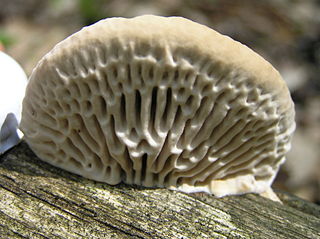
Daedalea is a genus of fungi in the family Fomitopsidaceae. The genus was circumscribed in 1801 by mycologist Christian Hendrik Persoon, based on the type D. quercina and four other species. The generic name is derived from the Ancient Greek δαιδαλεος.

Fomitopsis is a genus of more than 40 species of bracket fungi in the family Fomitopsidaceae.

Fomitopsis quercina is a species of mushroom in the order Polyporales. Commonly known as the thick-walled maze polypore, maze-gill fungusoak-loving maze polypore, or oak mazegill, the specific epithet refers to the oak genus Quercus, upon which it frequently grows, causing a brown rot. It is found in Europe, Asia, Northern Africa and Australasia. Though inedible, it can be used as a natural comb and has been the subject of chemical research.
Leif Randulff Ryvarden is a Norwegian mycologist.

Amauroderma is a genus of polypore fungi in the family Ganodermataceae. The genus, widespread in tropical areas, contains about 70 species. Amauroderma fungi are wood-decay fungi that feed and fruit on decayed branches and trunks.
Navisporus is a genus of seven species of tropical poroid fungi in the family Polyporaceae. It was circumscribed by Norwegian mycologist Leif Ryvarden in 1980 with Navisporus floccosus as the type species. This fungus, first described as Trametes floccosa by Giacomo Bresadola in 1896, is thought to have been originally collected in Tanzania.
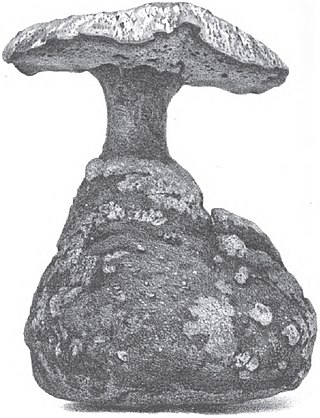
Laccocephalum basilapidoides, referred to as the stone-making fungus, is a fungus known only from Australia.

Lactifluus rupestris is a species of mushroom in the family Russulaceae. Described as a new species in 2010, it is known only from the semi-arid region in the National Park of Catimbau of Brazil. The mushroom is characterized by a stout fruit body with a smooth and sticky orange cap up to 7 cm (2.8 in) in diameter. The gills on the underside of the cap are closely spaced and frequently anastomosed. The stem is 35–45 mm (1.4–1.8 in) long by 18–21 mm (0.71–0.83 in) thick. The mushrooms exude a sparse cream-colored latex when cut or injured.

Lenzites warnieri is a species of fungus in the family Polyporaceae found in parts of Europe, Asia, and northern Africa. The species is a white rot pathogen on living wood. Its corky fruiting bodies in the shape of semicircular plates form on the trunks of several types of deciduous trees growing near water bodies in regions of moist sub-Mediterranean climate. The fruiting body, which has a lamellar fruit layer, produces spores only once.

Pycnoporellus alboluteus, commonly known as the orange sponge polypore, is a species of polypore fungus in the family Fomitopsidaceae. Distributed throughout the boreal conifer zone, the fungus is found in mountainous regions of western North America, and in Europe. It causes a brown cubical rot of conifer wood, especially spruce, but also fir and poplar. The soft, spongy orange fruit bodies grow spread out on the surface of fallen logs. Mature specimens have tooth-like or jagged pore edges. A snowbank mushroom, P. alboluteus can often be found growing on logs or stumps protruding through melting snow. Although the edibility of the fungus and its usage for human culinary purposes are unknown, several species of beetles use the fungus as a food source.
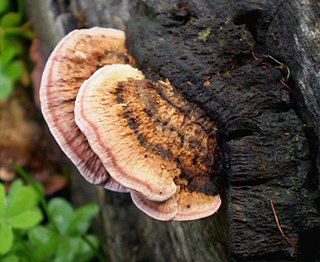
Rhodofomitopsis lilacinogilva is a species of bracket fungus in the family Fomitopsidaceae. Known primarily from Australia, it has also been recorded from Brazil and India. It is a white-rot fungus that grows on rotting eucalyptus wood. Its main identifying feature is the lilac colour of the pore surface on the underside of the fruit body.
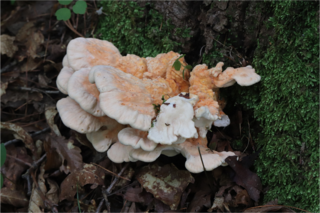
Laetiporus cremeiporus is a species of polypore fungus in the family Fomitopsidaceae. It is found in cooler temperate areas of China and Japan, where it grows on logs and stumps of hardwood trees, especially oak. The fruit body of the fungus comprises large masses of overlapping reddish-orange caps with a cream-colored pore surface on the underside.

Laetiporus gilbertsonii is a species of polypore fungus in the family Fomitopsidaceae. It is found in western North America and South America. It was one of three new Laetiporus species published in 2001, which were distinguished genetically from the common Laetiporus sulphureus; the others were L. conifericola and L. huroniensis. The type collection, made in San Francisco's Golden Gate Park in 1997, was found fruiting on a eucalyptus tree. It has also been collected in Oregon and Washington. The fungus is named in honor of mycologist Robert Lee Gilbertson. L. gilbertsonii is edible, although some people have reported experiencing upset stomach after consuming it. Laetiporus conifericola is very similar in appearance, but is readily distinguished by its growth on conifers.
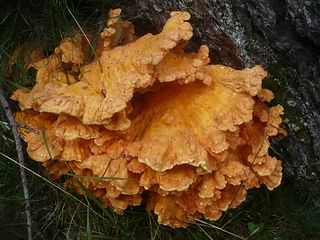
Laetiporus montanus is a species of polypore fungus in the family Fomitopsidaceae. It is found in mountainous areas of central Europe and in China, where it grows on conifers.
Nigroporus macroporus is a species of poroid fungus in the family Steccherinaceae. It was described as new to science in 2003 by mycologists Leif Ryvarden and Teresa Iturriaga. Found in Venezuela and Brazil, it is a wood-decay fungus that causes a white rot in the hardwood Dimorphandra macrostachya.
Ungulidaedalea is a fungal genus in the family Fomitopsidaceae. The genus was circumscribed by Chinese mycologists in 2016 to contain the single species Ungulidaedalea fragilis, a fungus that was described as new in 2014 with the name Fomitopsis fragilis. The holotype of this fungus was collected in Jianfengling Nature Reserve, in Ledong County (Hainan). The generic name Ungulidaedalea refers to the resemblance between this species and Daedalea, and also to the hoof-shaped (ungulate) form of the fruit body. Ungulidaedalea fragilis has rather fragile fruit bodies with a dark brown crust and large angular pores on the cap underside. Microscopic characteristics include its densely septated skeletal hyphae, and oblong-ellipsoid spores that measure 4–5.2 by 2.2–2.8 μm.
Amauroderma calcitum is a tough woody mushroom in the family Ganodermataceae. It is a polypore fungus found in Brazil.













